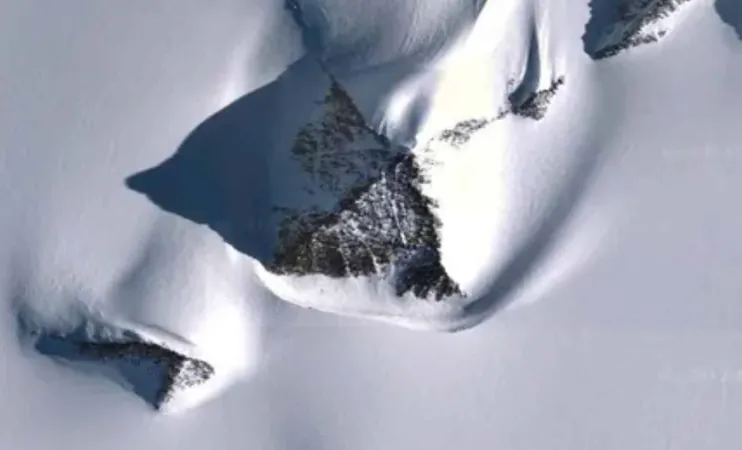
Unveiling Antarctica's Mysterious Pyramid: Nature's Marvel or Alien Enigma?
2025-05-10
Author: Mei
Antarctica’s Pyramid: A Geological Curiosity
Deep within the frigid reaches of Antarctica, an astonishing mountain peak has captured the world's attention with its striking resemblance to a perfectly shaped pyramid. Nestled in the Ellsworth Mountains, this unnamed giant first gained notoriety in 2016 when satellite images showcased its unusual form, prompting wild theories that ranged from ancient human civilizations to alien builders.
The Peak That Went Viral
Towering at 4,150 feet, this pyramid-like mountain is more than just an optical illusion; it holds geological significance. The U.S. Geological Survey (USGS) shed light on its age-old story in a 2007 study, revealing that this peak, like many others in the area, has been sculpted over millions of years through the relentless forces of erosion. The sharp symmetry of its four faces stirred imaginations worldwide, igniting speculation about its origins—but scientists insist this is an entirely natural formation.
Erosion Crafted the Antarctic Wonder
The striking form of this peak isn't manmade; it is the product of the slow, methodical forces of erosion, as explained by Dr. Mauri Pelto, a professor of environmental science. This unique pyramidal shape emerged from freeze-thaw erosion: water accumulates in the rock's cracks during the day and freezes overnight, causing the cracks to widen and erode. Over time, this process has meticulously sculpted the mountain into the geometric marvel we see today, with most of its sides shaped similarly, although the eastern ridge showcases an intriguing variance.
The Allure of Pyramid Shapes
Pyramids have a magnetic appeal that spans across cultures and ages, from the renowned structures of ancient Egypt to natural formations scattered around the globe. The Antarctic peak stands out thanks to its four steep sides, a rarity for mountains, as noted by Eric Rignot, a NASA scientist. While many mountains display a pyramidal aspect, few boast such symmetrical prominence, contributing to the awe and speculation surrounding this unique geological feature.
Ellsworth Mountains: A Geological Goldmine
The Ellsworth Mountains are a treasure trove of geological history, home to fossils that trace back to the Cambrian period—around 500 million years ago. These ancient remnants, including trilobites, paint a vivid picture of life in Earth's early epochs. This striking mountain emerges from a landscape shaped by countless erosive forces over millennia, and the USGS highlights the region as an ideal site for understanding the planet’s geological evolutions.
Setting the Record Straight on Alien Theories
The fascination surrounding the pyramid-like peak didn't just bring wonder; it also birthed conspiracy theories suggesting extraterrestrial involvement or lost civilizations. Experts swiftly refuted these claims, affirming that the peak is simply a natural geological formation. Rignot succinctly summarized, "This is just a mountain that looks like a pyramid." Echoing this, iconic formations like Switzerland’s Matterhorn also owe their unique shapes to natural erosion.
The Search for Nature's Hidden Pyramids
The buzz around Antarctica's pyramid has ignited a global hunt for other natural pyramidal structures. Geologists and enthusiasts are now on the lookout for similar formations around the world, each bearing the complex narrative of its geological origins, shaped by erosion, tectonic shifts, or volcanic activity. As exploration technology advances, it’s highly likely that we will uncover additional ‘pyramids’, providing even more stunning examples of nature’s artistic command in sculpting Earth's terrain.




 Brasil (PT)
Brasil (PT)
 Canada (EN)
Canada (EN)
 Chile (ES)
Chile (ES)
 Česko (CS)
Česko (CS)
 대한민국 (KO)
대한민국 (KO)
 España (ES)
España (ES)
 France (FR)
France (FR)
 Hong Kong (EN)
Hong Kong (EN)
 Italia (IT)
Italia (IT)
 日本 (JA)
日本 (JA)
 Magyarország (HU)
Magyarország (HU)
 Norge (NO)
Norge (NO)
 Polska (PL)
Polska (PL)
 Schweiz (DE)
Schweiz (DE)
 Singapore (EN)
Singapore (EN)
 Sverige (SV)
Sverige (SV)
 Suomi (FI)
Suomi (FI)
 Türkiye (TR)
Türkiye (TR)
 الإمارات العربية المتحدة (AR)
الإمارات العربية المتحدة (AR)